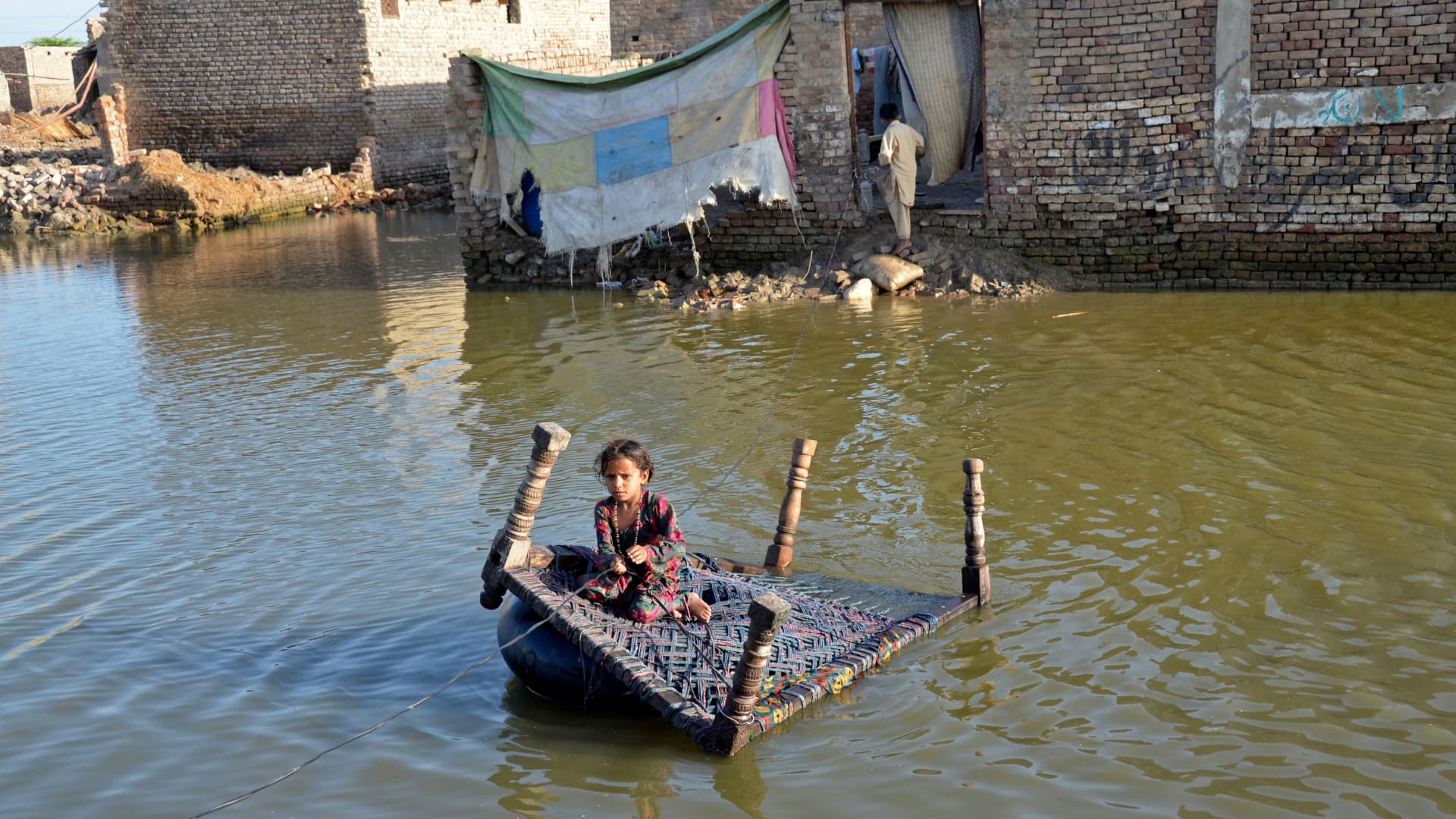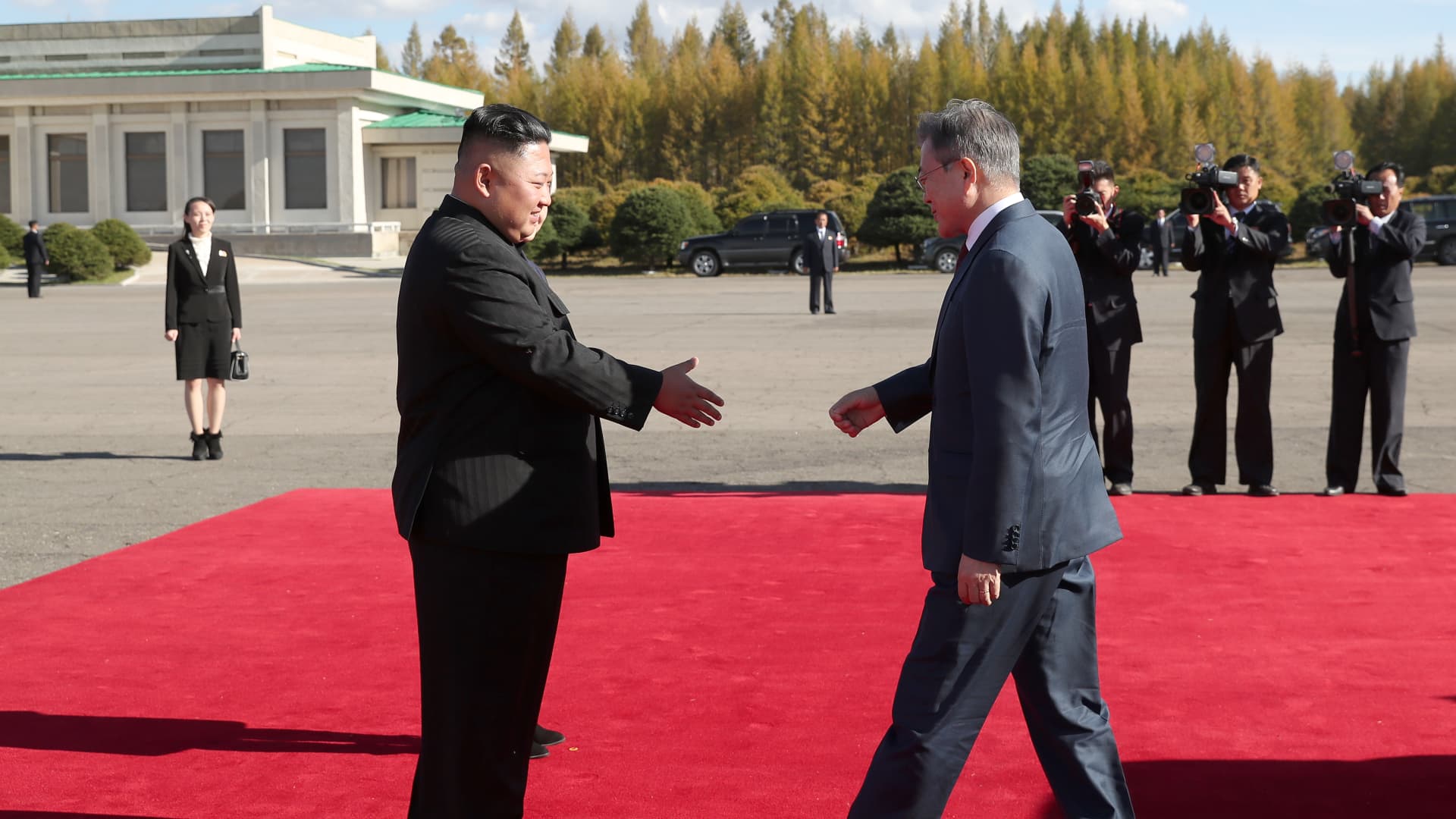Climate change has forced millions to flee their homes — and Asia is 'not prepared'
As climate disasters worsen, more people are being displaced from their homes. This is especially so in Asia, a region that's not prepared for what is to come.

A girl sits on a cot as she crosses a flooded street in Pakistan on October 4, 2022. A record 32.6 million internal displacements were associated with disasters in 2022 -- more than the 28.3 million with conflict and violence, according to the Internal Displacement Monitoring Centre.
Fida Hussain | Afp | Getty Images
As the number of climate disasters increase, more people are being forced to flee their homes, especially in Asia.
A record 32.6 million internal displacements were associated with disasters in 2022 — that's 41% higher than the annual average of the past decade, according to the Internal Displacement Monitoring Centre. It was far more than the 28.3 million people displaced by conflict and violence that same year.
In particular, four of the top five countries with the highest number of new internal displacements due to disasters in 2022 were in Asia, said the IDMC. Pakistan had the highest number at 8.2 million, followed by the Philippines at 5.5 million and China at 3.6 million.
The situation is set to get worse.
According to a 2021 World Bank report, climate change could force 216 million people across six regions to move within their countries by 2050.

However, Vinod Thomas, visiting senior fellow at ISEAS-Yusof Ishak Institute, noted that these estimates may understate the reality.
"Projections usually underestimate how bad things are, and all the projections point in one direction — this is going to increase, and increase very rapidly," said Thomas.
South Asia most at risk
In the region, South Asia is likely to have the most people displaced by climate change due to the density of its populations and its vulnerability to the effects of climate change, he added. In particular, he noted that Bangladesh, Pakistan and Afghanistan are likely to be the most affected.
According to the World Economic Forum, 10% to 18% of South Asia's GDP is at risk due to climate disasters. This is at about thrice the risk North America faces and 10 times more than Europe.
Climate change driven internal displacement has severe economic repercussions for the host country, said Thomas.
During Australia's Black Summer bushfires from 2019 to 2020, the loss of economic production of one person missing a day of work was about $510, according to the IDMC. There were 65,000 new displacements because of the bushfires.
Covering just the housing needs of those unable to return to their homes for a year was also estimated to cost between $44 million and $52 million, the IDMC said.
Projections usually underestimate how bad things are, and all the projections point in one direction — this is going to increase, and increase very rapidly.
Vinod Thomas
ISEAS-Yusof Ishak Institute
People displaced by climate disasters, however, could also decide to leave the country entirely.
"What we have seen regarding external movement is the tip of the iceberg and just a glimpse of what is likely to happen," Thomas said. "And we are not prepared for that."
Migration pathways
While internal displacement due to climate change is much more common than cross-border displacement, people may gradually start moving across borders as the effects of climate change worsen, said Tamara Wood, senior research fellow at the Kaldor Centre for International Refugee Law.
In November, Australia signed a migration deal with Tuvalu offering 280 citizens permanent residency in Australia each year.
In Southeast Asia, UNHCR senior advisor on migration and human rights Pia Oberoi told CNBC that many people are already moving in the face of climate change and environmental degradation.

However, such movements can sometimes be disguised as traditional migration flows such as labor migration, she said.
For instance, there is little research about why Bangladeshi migrant workers in Southeast Asia are moving overseas to work, often willing to take on large debts to do so.
Some have nothing to return to, Oberoi explained, as climate change may have hurt their crop production at home. Others may be returning to slum areas in the cities they were forced to move to if they return to their home country, she added.
Given that people may be forced to move in the context of climate change because they are no longer able to cope in their home countries, governments need to relook the migration channels they offer to see what more can be done to protect people's human rights, she said.
For example, it is not easy for people to return to see their families through these migration paths even though the right to family life is important, she added.
Wood noted that sustainable ways of helping those leaving their countries due to climate change should include offering them more than a visa, but also providing support like ensuring their qualifications are recognized or helping them integrate into the culture, and facilitating movement of money back home.
While we are talking and discussing and quibbling, the millions of climate migrants are the forgotten casualties of climate change.
Vinod Thomas
ISEAS-Yusof Ishak Institute
"We need to conduct better research to understand their situation and vulnerability, and then build that into pathways to provide a protective response," said Oberoi. Countries can look within their legal systems to figure out how to help people affected by climate change, she added.
Improving measures don't "always require putting in place a new category of protection or a new refugee definition or new humanitarian pathways," Oberoi said. "It could just be the pathways we already have responding adequately to the protection needs of people that are moving."
Wood said putting these measures in place can help those who want to make a preemptive decision to move, to do so in a controlled and well-planned way. That way, they can gradually adjust instead of being driven to do so when they reach crisis point, she added.
What more needs to be done
Countries need to focus on three steps to deal with climate displacement, said Thomas, citing relief and rehabilitation, adaptation to climate change and mitigation by decarbonizing economies.
He said Asian countries are not prepared for the relief and rehabilitation of refugees, and have done poorly in building social and financial safety nets.
Something to consider going forward would be a facility that pulls resources across countries and makes them available when needed, Thomas added.

"Most of the time, the problem is that when the problem hits, you're not ready with the financing," he said. "So the facility can be opened up as needed, and otherwise, it just earns interest."
When it comes to adaptation, the money allocated to such measures, such as coastal defenses, has to be considered as part of the investment budget — not an optional budget, Thomas said.
"We have to continuously increase adaptation capacity," said Thomas. "Being able to withstand and improve is what it takes to move the needle on climate migration."
Wood suggested that other countries, like the Global North or industrialized countries that have contributed more to climate change, should also step up. She said that could come in the form of providing migration pathways and work opportunities, as well as funding to help other countries adapt and manage the issue.
In 2009, developed countries promised to mobilize $100 billion a year by 2020 to help poorer nations hit by disasters caused by climate change. Last month, the OECD said the overdue promise may have been achieved.

But the fund is just a starting point and a mere drop in the bucket, Thomas pointed out, adding that public opinion needs to change and the pressure needs to be on politicians to take action now.
"In the meantime, while we are talking and discussing and quibbling, the millions of climate migrants are the forgotten casualties of climate change," said Thomas. "They are hidden, they have no voice, and they don't even have an identity."

 Konoly
Konoly 































